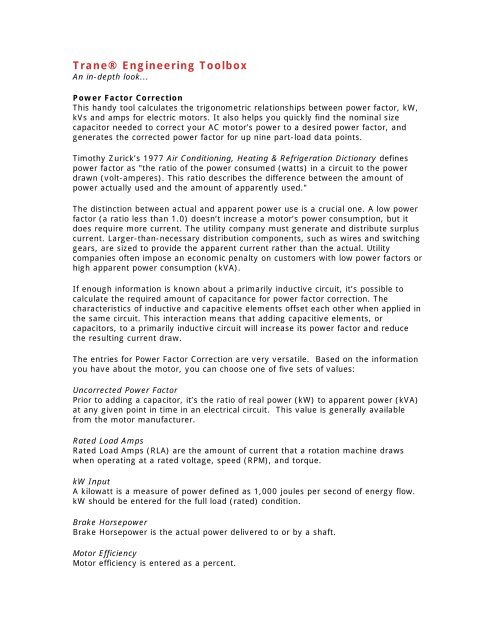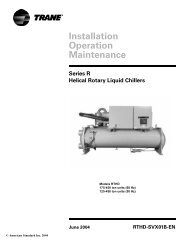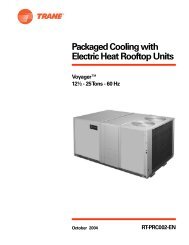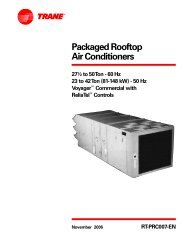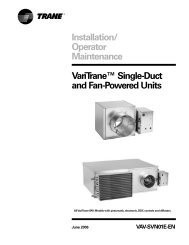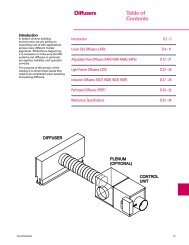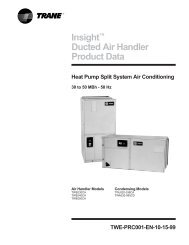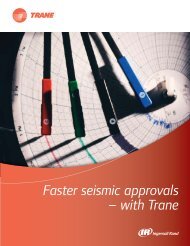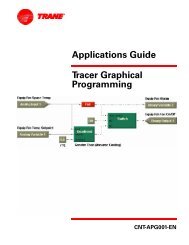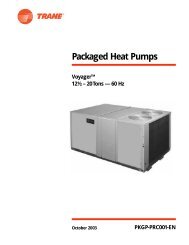Trane® Engineering Toolbox
Trane® Engineering Toolbox
Trane® Engineering Toolbox
You also want an ePaper? Increase the reach of your titles
YUMPU automatically turns print PDFs into web optimized ePapers that Google loves.
<strong>Trane®</strong> <strong>Engineering</strong> <strong>Toolbox</strong><br />
An in-depth look...<br />
Power Factor Correction<br />
This handy tool calculates the trigonometric relationships between power factor, kW,<br />
kVs and amps for electric motors. It also helps you quickly find the nominal size<br />
capacitor needed to correct your AC motor’s power to a desired power factor, and<br />
generates the corrected power factor for up nine part-load data points.<br />
Timothy Zurick’s 1977 Air Conditioning, Heating & Refrigeration Dictionary defines<br />
power factor as "the ratio of the power consumed (watts) in a circuit to the power<br />
drawn (volt-amperes). This ratio describes the difference between the amount of<br />
power actually used and the amount of apparently used."<br />
The distinction between actual and apparent power use is a crucial one. A low power<br />
factor (a ratio less than 1.0) doesn’t increase a motor’s power consumption, but it<br />
does require more current. The utility company must generate and distribute surplus<br />
current. Larger-than-necessary distribution components, such as wires and switching<br />
gears, are sized to provide the apparent current rather than the actual. Utility<br />
companies often impose an economic penalty on customers with low power factors or<br />
high apparent power consumption (kVA).<br />
If enough information is known about a primarily inductive circuit, it’s possible to<br />
calculate the required amount of capacitance for power factor correction. The<br />
characteristics of inductive and capacitive elements offset each other when applied in<br />
the same circuit. This interaction means that adding capacitive elements, or<br />
capacitors, to a primarily inductive circuit will increase its power factor and reduce<br />
the resulting current draw.<br />
The entries for Power Factor Correction are very versatile. Based on the information<br />
you have about the motor, you can choose one of five sets of values:<br />
Uncorrected Power Factor<br />
Prior to adding a capacitor, it’s the ratio of real power (kW) to apparent power (kVA)<br />
at any given point in time in an electrical circuit. This value is generally available<br />
from the motor manufacturer.<br />
Rated Load Amps<br />
Rated Load Amps (RLA) are the amount of current that a rotation machine draws<br />
when operating at a rated voltage, speed (RPM), and torque.<br />
kW Input<br />
A kilowatt is a measure of power defined as 1,000 joules per second of energy flow.<br />
kW should be entered for the full load (rated) condition.<br />
Brake Horsepower<br />
Brake Horsepower is the actual power delivered to or by a shaft.<br />
Motor Efficiency<br />
Motor efficiency is entered as a percent.
You must also enter either capacitance or Corrected Power Factor. Then, the<br />
<strong>Engineering</strong> <strong>Toolbox</strong> will solve for the remaining aspects.<br />
Corrected Power Factor<br />
Corrected power factor is the power factor with installed capacitors. If you are using<br />
the tool to calculate the amount capacitance required to attain a desired power<br />
factor, then the corrected power factor is the desired power factor.<br />
Installed Capacitance<br />
The amount of capacitance that must be added to the motor to attain the corrected<br />
power factor and line current.<br />
<strong>Engineering</strong> <strong>Toolbox</strong> returns the Line Current and Required Capacitance, as well as<br />
Corrected Power Factor.<br />
Required Capacitance is the amount of capacitance (in Kvar) that must be added to<br />
the motor to attain the Corrected Power Factor and Line Current.<br />
Capacitors used for Power Factor Correction are generally offered in predetermined<br />
sizes that seldom match the Required Capacitance. Typically, designers pick the<br />
closest-size capacitor that is smaller than the Required Capacitance to avoid<br />
overcorrecting.<br />
Standard capacitors are also cataloged at a specific voltage and frequency. If they<br />
are used at a different voltage or frequency, they must be re-rated to the new<br />
condition using the following equation:<br />
Kvar actual = Kvar rated × (V actual / V rated)² × (f actual / f rated)<br />
Properties of Air<br />
Properties of air is an electronic version of the Trane psychrometric chart. You enter<br />
any two properties of a known quantity of air and the program calculates the five<br />
other properties.<br />
Using one start point, this applet calculates all properties of moist or dry air at<br />
normal HVAC conditions. It’s an electronic version of the Trane psychrometric chart,<br />
and it uses the same calculating routines as TRACE 600 and TRACE Load 700. It’s so<br />
easy to read, too—no more incorrect interpretations!<br />
Enter any two values and the program will instantly calculate the other five<br />
properties (if pychrometrically possible). Engineer's <strong>Toolbox</strong> takes any combination<br />
of:<br />
• Altitude<br />
• Dry bulb<br />
• Wet bulb<br />
• Specific humidity<br />
• Enthalpy<br />
• Dew point<br />
• Relative humidity<br />
• Specific volume
and returns the remaining properties:<br />
• Altitude<br />
• Barometric pressure<br />
• Air pressure<br />
• Dry bulb<br />
• Wet bulb<br />
• Specific humidity<br />
• Enthalpy<br />
• Dew point<br />
• Relative humidity<br />
• Specific volume<br />
• Humidity ratio<br />
Try the web enabled Properties of Air calculator.<br />
Mixed Air Properties<br />
Enter psychrometric information about two known quantities of air and the program<br />
returns properties for the mixture of the two quantities. The Mixed Properties of Air<br />
applet is very similar to the Properties of Air applet.<br />
<strong>Engineering</strong> <strong>Toolbox</strong> requires values for both air quantities, including:<br />
• Quantity<br />
• Dry Bulb<br />
• Wet Bulb<br />
• Altitude<br />
With these values entered, <strong>Engineering</strong> <strong>Toolbox</strong> calculates values for each air<br />
quantity, as well as a combination of the two. Values calculated include:<br />
• Altitude<br />
• Barometric pressure<br />
• Air quantity<br />
• Air pressure<br />
• Dry bulb<br />
• Wet bulb<br />
• Humidity ratio<br />
• Humidity<br />
• Specific humidity<br />
• Enthalpy<br />
• Specific volume<br />
• Dew Point<br />
• Relative humidity<br />
Try the web-enabled version of the Mixed Air Properties calculater for yourself!<br />
Fluid Properties<br />
Calculates physical properties of the five different fluids used in HVAC applications<br />
including water, ethylene glycol, propylene glycol, calcium chloride, and methanol<br />
brine.
<strong>Engineering</strong> toolbox requires values for fluid type, temperature, and concentration,<br />
to calculate:<br />
• Temperature concentration<br />
• Viscosity<br />
• Freezing point<br />
• Specific gravity<br />
• Thermal conductivity<br />
• Specific heat<br />
Refrigerant Properties<br />
Calculates several properties of ten commonly used refrigerants.<br />
• CFC-11 (R-11)<br />
• CFC-12 (R-12)<br />
• HCFC-22 (R-22)<br />
• HFC-32 (R-32)<br />
• CFC-113 (R-113)<br />
• CFC-114 (R-114)<br />
• HCFC-123 (R-123)<br />
• HFC-134a (R-134a)<br />
• CFC-500 (R-500)<br />
• CFC-502 (R-502)<br />
<strong>Engineering</strong> <strong>Toolbox</strong> requires entries for Refrigerant type, Temperature and<br />
Concentration. In return <strong>Engineering</strong> <strong>Toolbox</strong> calculates:<br />
• Temperature concentration<br />
• Liquid enthalpy<br />
• Liquid viscosity<br />
• Liquid thermal conductivity<br />
• Specific heat<br />
• Density<br />
• Vapor enthalpy<br />
• Vapor viscosity<br />
• Vapor thermal conductivity<br />
• Vapor entropy<br />
• Sonic velocity<br />
• Specific heat<br />
• Specific volume
Refrigerant Line Sizing<br />
This calculator combines refrigerant properties and piping design fundamentals to<br />
compute line sizes for suction, discharge, and liquid lines of split systems using R-12<br />
or R-22.<br />
System values required are:<br />
• Refrigerant type<br />
• Saturated suction temperature<br />
• Condensing temperature<br />
• Evaporator tonnage<br />
• Superheat<br />
• Subcooling<br />
• Compressor superheat<br />
The discharge line connects the outlet of the compressor to the condenser. In a<br />
"condensing unit," the discharge line is an integral part of the packaged piece of<br />
equipment and need not be sized.<br />
<strong>Engineering</strong> <strong>Toolbox</strong> selects a discharge line to maintain the velocity of the<br />
refrigerant vapor below 3,500 fpm and the total pressure drop in the discharge line<br />
below 6 psi.<br />
When selecting a line size, be sure that the minimum tons reported for the line are<br />
lower than the minimum capacity of the refrigeration circuit. If it is not, reduce the<br />
line size of vertical risers only. If the minimum tons for a 30-ton circuit are reported<br />
as 11.6 tons for a 1-5/8" discharge line, this means that the refrigerant can carry oil<br />
in this size line down to 11.6 tons. As long as the minimum capacity of the circuit is<br />
greater than 11.6 tons, the line size is acceptable. If it is not, the vertical riser<br />
sections of the line should be reduced one size to 1-3/8".<br />
It is good practice to maintain refrigerant velocity above 500 fpm.<br />
Discharge line values required include:<br />
• Line length<br />
• Ball valve count<br />
• Angle valve count<br />
• Short elbow count<br />
• Long elbow count<br />
• Tee "thru" count<br />
• Tee "branch" count<br />
The liquid line connects the condenser to the expansion device, which is at the inlet<br />
of the evaporator.<br />
<strong>Engineering</strong> <strong>Toolbox</strong> selects a liquid line to maintain the velocity of the liquid<br />
refrigerant below 600 fpm and to maintain subcooling greater than 5° F at the inlet<br />
to the expansion device. The system needs to have enough subcooling so that the<br />
refrigerant will not flash to vapor before it reaches the expansion valve. It ensures
this by selecting a line size that will have at least 5° F of subcooling remaining at the<br />
inlet of the expansion valve.<br />
For R-22 ... When vertical upward flow exists in the liquid line (i.e., when the<br />
condenser is located below the evaporator), loss of head pressure due to the column<br />
effect of the liquid must be taken into consideration. The loss of head pressure is<br />
most likely to occur when the liquid is very dense (liquid temperature is low). To<br />
avoid loss of head pressure in vertical upward lines, an adjustment factor is applied<br />
to the subcooling before the expansion valve so, that the program does not choose a<br />
line that will not perform when the outdoor conditions are not at design. The<br />
adjustment factor applied is based on the properties of refrigerant R-22 at 50° F. For<br />
every 10 feet of upward flow 3.2° F is subtracted from the subcooling before the<br />
expansion valve; 5 °F before the expansion must still be maintained even with the<br />
adjustment factor.<br />
Liquid line values required include:<br />
• Line length<br />
• Ball valve quantity<br />
• Angle valve quantity<br />
• Short elbow quantity<br />
• Long elbow quantity<br />
• Tee "thru" quantity<br />
• Tee "branch" quantity<br />
• Filter drier<br />
• Solenoid valve<br />
• Elevation change<br />
The suction line connects the evaporator to the compressor inlet.<br />
<strong>Engineering</strong> <strong>Toolbox</strong> selects a suction line to maintain the velocity of the refrigerant<br />
vapor below 4,000 fpm and the total pressure drop in the suction line below 6 psi.<br />
When selecting a line size, be sure that the minimum tons reported for the line is<br />
lower than the minimum capacity of the refrigeration circuit. If not, reduce the line<br />
size of vertical risers only. For example, if the minimum tons for a 30-ton circuit is<br />
reported as 11.7 tons for a 2-1/8" suction line, this means that the refrigerant can<br />
carry oil in this size line down to 11.7 tons. As long as the minimum capacity of the<br />
circuit is greater that 11.7 tons, the line size is acceptable. If it is not, the vertical<br />
riser sections of the line should be reduced one size to 1-5/8".<br />
It is a good practice to maintain refrigerant velocity above 500 fpm. Suction line<br />
values required include:<br />
• Line length<br />
• Ball valve quantity<br />
• Angle valve quantity<br />
• Short elbow quantity<br />
• Long elbow quantity<br />
• Tee "thru" quantity<br />
• Tee "branch" quantity<br />
• Suction filter quantity
Electronic Ductulator®<br />
The electronic version of the Trane Ductulator, simplifies the manual process of<br />
sizing ductwork based on equal-friction methodology. It computes the friction rate or<br />
pressure drop in a particular duct so that you can specify an appropriate nominal<br />
size.<br />
The equal-friction-duct sizing methodology attempts to keep the pressure drop, per<br />
unit length of duct, relatively constant throughout the system. It is widely used to<br />
size relatively low-velocity constant-volume systems and to size the flexible ductwork<br />
between each VAV box and diffuser.<br />
Use the entries in the Ductulator window to describe the physical characteristics of<br />
the duct and specify two performance parameters (typically airflow and velocity).<br />
The program will calculate the friction rate and dimensions. With that information,<br />
enter a nominal duct size that approximates the calculated value(s) and let the<br />
program determine the new friction rate and velocity.<br />
Ductulator requires the following information to solve the equal-friction-related<br />
equations:<br />
• Duct shape<br />
• Material type<br />
• Roughness<br />
• Duct ID<br />
• Length<br />
Plus any two of these variables: Airflow, Friction Rate and Velocity Dimensions.<br />
For round duct, enter the Diameter plus Airflow or Friction Rate or Velocity.<br />
For rectangular or oval duct, either:<br />
• Enter the Height and Width PLUS Airflow or Friction Rate or Velocity. These<br />
entries can be made in any order.<br />
• Enter one dimension (either Height or Width) plus two other variables from<br />
among Airflow, Friction Rate and Velocity. This method fixes the duct height<br />
or width if you enter the value before completing the other entries.<br />
Remember that you can represent fittings and terminations by defining equivalent<br />
lengths of straight duct.<br />
On completing these calculations, the program automatically displays the Ductulator<br />
Report in spreadsheet format. Use the click-and-drag borders between the headings<br />
to adjust the column widths and the horizontal scroll bar to aid onscreen viewing.


